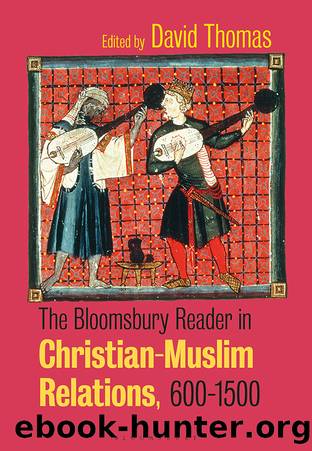The Bloomsbury Reader in Christian-Muslim Relations, 600-1500 by David Thomas;

Author:David Thomas;
Language: eng
Format: epub
Publisher: Bloomsbury UK (Minor Textbooks)
40
Sebeos the Armenian, History of Sebeos
Rachel Claire Dryden, University of Cambridge
Sebeos was an Armenian bishop of the mid-seventh century. The mistaken attribution of this work, known as Patmutâiwn Sebeosi (âHistory of Sebeosâ), to him has stuck, though this does not detract from its importance as the longest and most substantial non-Muslim source, contemporary with events surrounding the first Arab conquests up to the year 655 (see J. Howard-Johnston, Witnesses to a World Crisis, p. 76). It was probably written in the 650s by an author whose knowledge of the Bible suggests he was a churchman. It details the accession and reign of the Persian Shah Khosrov II (r. 590/91â628) â hence its alternative title, History of Khosrov â and the war between him and the Romans (603â28), as well as the early Arab conquests. It includes brief biographical details about Muḥammad, charting his rise from merchant to preacher, and identifying the Arabs with the fourth empire symbolized by the last of the apocalyptic beasts depicted in the book of Daniel, that would trample and crush the entire earth (Patmutâiwn Sebeosi, p. 44, cf. Daniel 7). The third section, which relates the Arab conquests and the rise of Islam in the seventh century, remains the âonly wide-ranging, connected account to be found in a non-Muslim source written close to the events in the seventh centuryâ, without which it would be impossible to reconstruct the early history of Islam with any certainty (Howard-Johnston, Witnesses, p. 100).
The value of the Patmutâiwn Sebeosi lies not only in its content, but in its historical detail and precision. Although the work was known in the Middle Ages, the earliest manuscript, from 1568, has since disappeared, and a 1672 copy remains the earliest extant version. The absence of a colophon led to its author being identified as Sebeos when the text was first published in 1851.
CMR 1, pp. 139â44. See further:
J. Howard-Johnston, Witnesses to a World Crisis: Historians and Histories of the Middle East in the Seventh Century, Oxford, 2010.
This translation is taken from R.W. Thomson and J.D Howard-Johnston, The Armenian History Attributed to Sebeos, Liverpool, 1999, with permission.
Download
This site does not store any files on its server. We only index and link to content provided by other sites. Please contact the content providers to delete copyright contents if any and email us, we'll remove relevant links or contents immediately.
Getting It, Then Getting Along by L. Reynolds Andiric(629)
Religion and Politics Beyond the Culture Wars : New Directions in a Divided America by Darren Dochuk(446)
Global Justice, Christology and Christian Ethics by Lisa Sowle Cahill(408)
Positive Psychology in Christian Perspective: Foundations, Concepts, and Applications by Charles Hackney(340)
Forgiveness and Christian Ethics by Unknown(326)
Douglas Hamp The First Six Days by Unknown(256)
The Horrors and Absurdities of Religion by Arthur Schopenhauer(240)
Insurgency, Counter-insurgency and Policing in Centre-West Mexico, 1926-1929 by Mark Lawrence(234)
Christian Martyrdom and Christian Violence by Matthew D. Lundberg;(222)
The Oxford Handbook of Greek and Roman Mythography by R. Scott Smith;Stephen M. Trzaskoma;(216)
Beyond Heaven and Earth by Gabriel Levy(210)
God and Eros by Patterson Colin;Sweeney Conor;(207)
The Bloomsbury Reader in Christian-Muslim Relations, 600-1500 by David Thomas;(204)
Autobiography, Volume 2: 1937-1960, Exile's Odyssey by Mircea Eliade(194)
Cult Trip by Anke Richter(192)
Witches: the history of a persecution by Nigel Cawthorne(188)
An Introduction to Kierkegaard by Peter Vardy(177)
The Global Repositioning of Japanese Religions by Ugo Dessi(172)
The Believer by Sarah Krasnostein(171)
